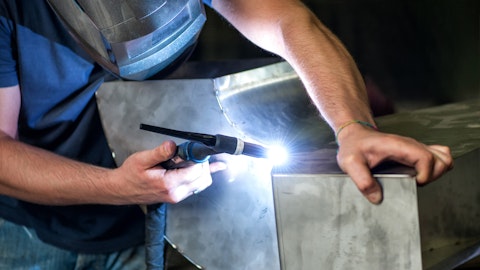One of the things that we had talked about is that it would take us this year to get through that aspect of PLS and begin to focus on growth. I was very happy with the progress that the North American team made as the quarter rolled on. We saw improvement starting in July, all the way to September in terms of volume. To answer your question as to the volume impact, we have said this – if you exclude the PLS volume impact, we had low single digit growth in the region. All in all, in our view, really strong initiatives, something that we believe is going to be a core toolkit of ours, with a big focus on growth as well. We’re demonstrating that in the Middle East and demonstrating that in Europe.
Nathan Jones: Thanks for that. Is it your opinion, then, that the impact of PLS–I know PLS won’t be an ongoing initiative, but the major impacts that we’re seeing at least to the top line in the Americas, you’re talking about probably five points of volume or something like that, that you’re dragging on revenue in 2023, that we should see the end of the major impacts for that and be into a more normal cadence, where we can more easily identify the impacts to growth of these tools in 2024?
Shyam Kambeyanda: That’s right. Our intent is to sort of exit this year and be in a spot where the comparables are sort of more equal and excluding sort of the big PLS impacts that we’ve made this year in the North American and Americas market. That’s correct.
Nathan Jones: Awesome. Thanks very much for taking my questions.
Shyam Kambeyanda: Thanks Nathan.
Operator: Your next question comes from the line of Mig Dobre from Baird. Your line is open.
Mig Dobre: Hey, good morning guys. Thank you for the question. If I may, I’d like to see if you could unpack your growth a little bit more. On Slide 3 here–rather Slide 4, you mention that equipment and automation volumes were up low double digits. Just running basic math, it looks like your consumables were flat and your growth and volume was really kind of all driven by equipment and automation, so correct me if I’m wrong there. What I’d like to understand from you is sort of how you see these two sides of your business progressing into the fourth quarter or, maybe if you’re willing to comment even beyond that, how sustainable is this growth in equipment and automation, and what do you think is happening with volumes just on the consumable side? Thank you.
Shyam Kambeyanda: Yes, thanks Mig. Always good to hear from you. A couple of aspects. The first piece is something that I spoke about in my prepared comments, was that in 2016, we really did not have an equipment line. One of the best stories that came out of Fabtech and Essen was the excitement our sales team saw with the fact that we now have a full toolkit and a line-up to go sell on equipment, and the progress that we’ve made in creating automation solutions with our new Warrior Edge product line. Fundamentally, think of it as ESAB was playing back in 2016 primarily as a consumables franchise, to today we have now got a full product line on the Fabtech side to go out and get behind, and our sales teams and our customers to rally behind.
We’re seeing a lot of excitement on that particular front, we’re seeing a lot of engagement, and so we fundamentally believe that over the next couple of years, we will be able to sell more equipment vis-à-vis consumables. That being said, the assumption that you’re making primarily is the right assumption, which is equipment and automation is growing faster than consumables, but probably the incorrect part of it is that the underlying, we did see consumables growth as well, just not as much. We feel that this journey continues for us. Our position of strength in the geographies that we spoke about is significant. Our ground game is bar none and unparalleled. We genuinely feel that our teams are now executing our ESAB growth playbook and EBX playbook quite well, and so we believe that we continue to have an opportunity to gain share and drive volumes to be positive over the coming years.


